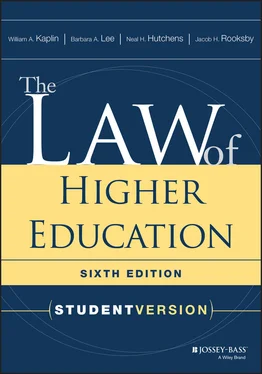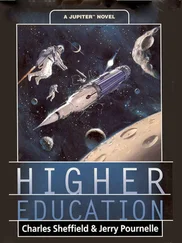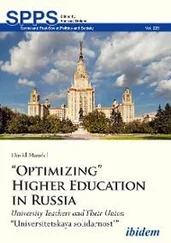Of course, some counter-trends have emerged over time that have served to ameliorate the more negative aspects of the greater role of law and litigiousness in academia. The alternative dispute resolution (ADR) movement in society generally has led to the use of mediation and other constructive mechanisms for the internal resolution of campus disputes, such as restorative justice programs (see Section 2.3of this book). Colleges and universities have increased their commitments to and capabilities for risk management and preventive legal planning. On a broader scale, not only institutions but also their officers have increasingly banded together in associations to maximize their influence on the development of legislation and agency regulations affecting postsecondary education. These associations also facilitate the sharing of strategies and resources for managing campus affairs in ways that minimize legal problems. Government agencies have developed processes for “notice” and “comment” prior to implementing regulations, for negotiated rule making, and for mediation of disputes. The trial courts have developed processes for pretrial mediation, and the appellate courts, including the U.S. Supreme Court, have developed a concept of “judicial deference” or “academic deference” that is used by both trial and appellate courts to limit judicial intrusion into the genuinely academic decisions of postsecondary institutions.
Administrators, counsel, public policy makers, and scholars have all reflected on the role of law on campus. While the influence of law is frequently criticized, this criticism is becoming more perceptive and more balanced. It is still often asserted that the law reaches too far and speaks too loudly. Especially because of the courts' and federal government's involvement, it is said that legal proceedings and compliance with legal requirements are too costly, not only in monetary terms but also in terms of the talents and energies expended; that they divert higher education from its primary mission of teaching and scholarship; and that they erode the integrity of campus decision making by bending it to real or perceived legal technicalities that are not always in the academic community's best interests. It is increasingly recognized, however, that such criticisms—although highlighting pressing issues for higher education's future—do not acknowledge all sides of these issues. We cannot evaluate the role of law on campus by looking only at dollars expended, hours of time logged, pages of compliance reports completed, or numbers of legal proceedings participated in. We must also consider a number of less-quantifiable questions: Are legal claims made against institutions, faculty, or staff usually frivolous or unimportant, or are they sometimes justified? Are institutions providing effective mechanisms for dealing with claims and complaints internally, thus helping themselves avoid any negative effects of outside legal proceedings? Are the courts and counsel for colleges and universities doing an adequate job of sorting out frivolous from justifiable claims and of developing means for summary disposition of frivolous claims and settlement of justifiable ones? Have administrators and counsel ensured that their legal houses are in order by engaging in effective preventive planning? Are courts being sensitive to the mission of higher education when they apply legal rules to campuses and when they devise remedies in suits lost by institutions? Do government regulations for higher education implement worthy policy goals, and are they adequately sensitive to the mission of higher education and to the level of governmental financial support that is provided to achieve desired aims? In situations where the message of the law has appeared to conflict with the best interests of academia, how has academia responded? Has the inclination been to kill the messenger or to develop more positive remedies—to hide behind rhetoric or to forthrightly document and defend the interests of higher education?
We still do not know all we should about these questions. But we know that they are clearly a critical counterpoint to questions about money, time, and energy expended. We must have insight into both sets of questions before we can fully judge law's impact on the campus—before we can know, in particular situations, whether law is more a beacon or a blanket of ground fog.
Section 1.2. Evolution of Higher Education Law
Throughout the nineteenth and much of the twentieth centuries, the law's relationship to higher education was very different from what it is now. There were few legal requirements relating to the educational administrator's functions, and these requirements were not a major factor in most administrative decisions. Those in the higher education world, moreover, tended to think of themselves as removed from and perhaps above the world of law and lawyers. The roots of this traditional separation between academia and law are several.
Higher education (particularly private education) was often viewed as a unique enterprise that could regulate itself through reliance on tradition and consensual agreement. It was thought to operate best by operating autonomously, and it thrived on the privacy afforded by autonomy. Academia, in short, was like a Victorian gentlemen's club whose sacred precincts were not to be profaned by the involvement of outside agents in its internal governance.
The unique higher education environment was also thought to support a special virtue and ability in its personnel. College faculty and administrators (often themselves respected scholars) had knowledge and training far beyond that of the general populace, and they were charged with the guardianship of knowledge for future generations. Theirs was a special mission pursued with special expertise and often at a considerable financial sacrifice. The combination spawned the perception that ill will and personal bias were strangers to academia and that outside monitoring of its affairs was therefore largely unnecessary.
The law to a remarkable extent reflected and reinforced such attitudes. Federal and state governments generally avoided any substantial regulation of higher education. Legislatures and administrative agencies imposed few legal obligations on institutions and provided few official channels through which their activities could be legally challenged. What legal oversight existed was generally centered in the courts. But the judiciary was also highly deferential to higher education. In matters concerning students, courts found refuge in the in loco parentisdoctrine borrowed from early English common law. By placing the educational institution in the parents' shoes, the doctrine permitted the institution to exert almost untrammeled authority over students' lives.
Nor could students lay claim to constitutional rights in the higher education environment. In private education the U.S. Constitutionhad no application; and in the public realm courts accepted the proposition that attendance at a public postsecondary institution was a privilege and not a right. Being a “privilege,” attendance could constitutionally be extended and was subject to termination on whatever conditions the institution determined were in its and the students' best interests. Occasionally courts did hold that students had some contractrights under an express or implied contractual relationship with the institution. But—as in Anthony v. Syracuse University , 231 N.Y.S. 435 (N.Y. App. Div. 1928), where the court upheld the university's dismissal of a student without assigning any reason other than that she was not “a typical Syracuse girl”—contract law provided little meaningful recourse for students. The institution was given virtually unlimited power to dictate the contract terms; and the contract, once made, was construed heavily in the institution's favor.
Читать дальше












